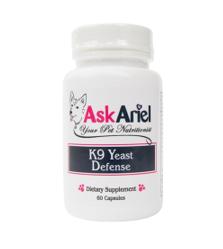Dog Yeast Infection Treatment
Today’s guest post features Ask Ariel! Ask Ariel Your Pet Nutritionist offers expert advice about pet nutrition and holistic pet health. Their exceptional quality supplements were developed based on Pet Nutritionist Susan Blake Davis’ experiences rescuing and rehabilitating homeless shelter animals. Ask Ariel supplements have been used successfully in veterinary hospitals since 2005 and are recommended by veterinarians nationwide. Purchases from links in this post provide proceeds that go 100% to furthering GARC’s mission!
Askariel.com is offering $5 savings on an order over $50. Use coupon code new5 at checkout.
Is your dog constantly chewing on his paws? Does your dog smell like cheese or corn chips even after a bath? It could be a sign of yeast. Yeast is a type of fungus that naturally resides on your dog’s body and can overgrow, leading to a smelly, itchy yeast infection. Yeast often affects a dog’s ears, groin, face and paws. Yeast infections in dogs are more prevalent during the spring and summer months due to increased moisture from activities like swimming and higher humidity levels. These conditions create optimal environments for yeast to thrive, especially in areas of the dog’s body prone to moisture retention, such as skin folds and paw pads.
How Yeast Can Impact Your Dog’s Health
Ears: Excess moisture, dirt, and wax buildup create an ideal environment for yeast to thrive. The resulting infection can cause a foul, musty odor emanating from the ears. Ear yeast infections tend to occur more frequently during the spring and summer months, as the combination of yeast and bacteria can become trapped in the ear canal amidst the warmer and more humid weather conditions. Dogs with floppy ears that restrict airflow, are prone to yeast infections in their ear canals.
Skin Folds: Breeds with skin folds, such as Bulldogs, Pugs, and Shar-Peis, are susceptible to yeast infections in these areas due to trapped moisture and limited airflow. The folds create warm, moist environments where yeast can grow, leading to a characteristic yeasty smell.
Paws: Yeast can also affect the skin between a dog’s toes and paw pads, particularly if the paws remain damp for extended periods. Dogs that frequently walk on damp surfaces or have excessive hair between their toes are more prone to yeast overgrowth in this area. Yeast infections in the paws can produce a yeasty, musty odor.
Itching & Rubbing: Dogs with a yeast infection feel uncomfortable. They may rub their face or rear end into the carpet. They may lick at their groin or genitals to relieve the discomfort. They may scratch incessantly, have hair loss or get blackened patches on their skin.
Causes of Yeast Infections In Dogs
Dogs can develop yeast overgrowth and subsequent infections for various reasons. Here are some common factors that contribute to yeast infections in dogs:
Moisture: Yeast thrives in warm, moist environments especially humid locations.
Poor Hygiene: Dogs that are not groomed regularly, especially in areas prone to yeast infections such as ears, skin folds, and paw pads, are more likely to develop yeast-related issues.
Allergies: Allergic reactions, whether to food, environmental allergens, or flea bites, can compromise your dog’s skin integrity and disrupt the natural balance of bacteria and yeast.
Immune System Disorders: Dogs with weakened immune systems due to genetic factors, autoimmune diseases, or certain medications are more prone to yeast overgrowth.
Underlying Health Conditions: Certain medical conditions, such as hormonal imbalances (e.g., hypothyroidism or Cushing’s disease), diabetes mellitus, and seborrheic dermatitis, can predispose dogs to yeast infections.
Dietary Factors: High-carbohydrate diets, excessive sugar consumption, or food sensitivities/allergies can contribute to yeast overgrowth.
Environmental Factors: Exposure to certain environmental factors, such as humidity, temperature changes, and swimming in bodies of water, can increase the likelihood of yeast infections.
By addressing these predisposing factors and implementing preventive measures, dog owners can help reduce the risk of yeast infections in their pets.
Natural Remedies For Yeast Infections In Dogs
Feeding your dog a While it’s important to consult with a veterinarian for proper diagnosis and treatment of yeast infections in dogs, there are some natural anti-fungal remedies may help alleviate symptoms and promote healing. Here are some ingredients to look for:
Caprylic Acid For Dogs – Caprylic acid, a natural compound found in coconut oil, can aid dogs with yeast infections by disrupting the cell walls of yeast, effectively inhibiting its growth and promoting a healthier balance of microorganisms.
Pau d’Arco For Dogs – Pau d’Arco has antifungal properties that can inhibit yeast
growth and can help strengthen the immune system to prevent recurrent infections.
Grapefruit Seed Extract contains compounds that exhibit potent antifungal activity, especially in the gastrointestinal tract whe re yeast issues often originate.
Echinacea Root (Echinacea angustifolia) is known for its immune-boosting properties. It can enhance the dog’s immune system, helping it better fight off yeast-related problems.
Oregano is a natural herb with strong antimicrobial and antifungal properties. It can help control yeast overgrowth in the dog’s system.
Antifungal natural remedies work to combat yeast overgrowth in dogs by inhibiting the growth of harmful fungi, restoring the balance of beneficial microorganisms, and supporting your pet’s natural defenses against infection, ultimately aiding in the alleviation of symptoms, and promoting overall good health.


